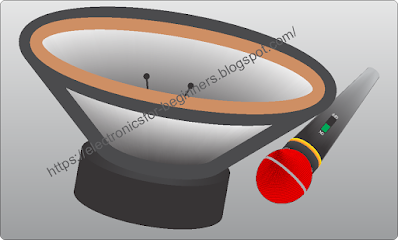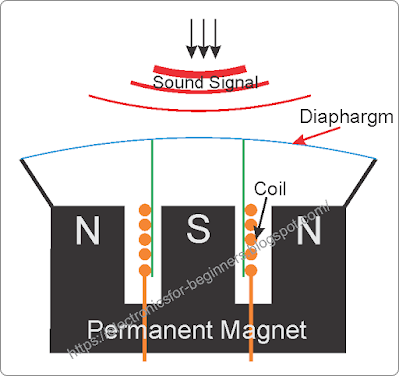Speaker
is a transducer which can convert electrical energy into sound energy. We
learned in previous post of DC motor about “Fleming's Left Hand rule” which is the
base behind working of motor. On the same principal we will see the working of
a speaker, how it produce sound waves when electrical current is applied to its
coil. We find speakers in every audio system, where the audio signals are
amplified through an audio amplifier and then fed to speakers which reproduces
the audio signals in form of sound waves.
As
we see in the diagram a coil is wound on a cylindrical hollow tube which is kept in the magnetic field of a permanent magnet. As per Fleming,s Left Hand
rule, if a current carrying conductor is kept in magnetic field, it experience a
force on it. It also says that the direction of force changes with change in
direction of current in wire. Also its is observed that the amplitude of force
depend on strength of current and strength of magnetic field. Here the coil
carries amplified audio signal converted in form of current. This signals is in
form of changing voltage hence the displacement of the coil keeps changing from
its initial position. In other words the coil assembly keeps vibrating while the
audio input is fed in the coil.
This
type of assembly is housed in a bigger circular housing with diameter starting
from 2-inches to 12-inches or even higher. Requirement of such larger size is to
amplify the effect of coil vibration so that sound waves generated from
speakers can travel a longer distance and can reach to audience. We know sound
waves travel in air in form for vibrations. As we see in this diagram, the coil
is kept in in middle of magnetic field of a permanent magnet. The coil is
attached with a large paper cone which is having diameter equal to the diameter
of speaker. So when the coil vibrates, it pushes the big size paper cone which
displaces large amount of air during vibration. This vibrating air when reaches
audience ears, sound is heard.
Since
there is very fine gap between two poles of magnet and the coil, hence if any
dust particle enters in this area, it may obstruct vibration of coil. To avoid
this a cap is placed on the cylindrical coil. The other component which holds
the coil in place is called spider which gives some strength so that the coil
does not vibrates to extreme position. This avoids hammering of coil with
magnet, means if the coil comes to extremer lower position, it will hit the
magnet hence it will not produce clear sound.
Symbol
of speaker is as shown here, it depicts its physical construction with two terminals to connect to circuit.
There are
three specification of a speaker:
- Size
of speaker: It is the diameter of the speaker metallic frame which hold all its
components. It is measured in inches and is available in size from as small as
2-inches to 12-inches and more. More size displaces more air hence sound travels
a longer distance.
- Resistance
of coil: It is the resistance of the speaker coil measured in Ohms, its
available in 4Ω, 6Ω, 8Ω etc.
- Power
of Speaker: It is the maximum output a speaker can generate in the form of
sound wave. The more the power rating, the more sound it can generate and can travel longer distance. It is measured in Watts or ‘W’. We can get speaker of
0.5W to 100W and more.
 |
Fleming's Right Hand
Rule
|
Next
let us learn about another theory called “Fleming's Right Hand” rule. This
rule is exactly reverse of left hand rule. It states that if we stretch our thumb,
index finger and middle finger in such a way that all of them are perpendicular
to each other (as shown in diagram), and consider that middle finger shows the
direction of magnetic field and thumb indicates the direction of motion of a
conductor placed in the magnetic field, then the direction of induced current
in the coil is in the direction pointed by middle finger. Using this concept we
make electric generators and on the same principal a microphone also works.
A
microphone is a transducer which converts sound energy into small electrical energy, which is then amplified with an audio amplifier and then fed to
speakers to reproduce that sound in large amplitude. As we see in diagram, it
consist of almost similar coil and permanent magnet structure. The coil is
again attached with a small diaphragm which vibrates from the sound waves when
some of speaks in front of it. This vibration forces the coil also to move up
and down in the magnetic field. As per the above law a current is induced in
the coil whose direction is decided by direction of magnetic field and
amplitude of vibration. This induced current is a direct conversion of sound
waves into electrical current which needs to be amplified to feed to any
speaker. This is because the induced current is not enough to directly drive a
speaker. We can see that a microphone works just reverse to a speaker and the
basic physics behind them is also just opposite to each other.
The
symbol of microphone is as shown here. There are multiple verity of microphones
available with different construction and their use. The example explained here
is the basic microphone. The function of all other microphones is same that is
to convert sound energy in electrical energy. Most popular now a days is condenser microphone which are mostly used in mobiles and its hands-free. Its
basically a small capacitor with one plate fixed and other plate flexible to
vibrate with sound wave. As it vibrates, the distance between two plates
changes which changes its capacitance. This change in capacitance is converted
into electrical signal through some circuitry around it and then amplified and
fed to speaker or sent over mobile network to other end listener.
That's all about basics of speaker and microphone, keep watching for more new topics and subscribe over email to get alerts when a new topic is posted.















0 Comments